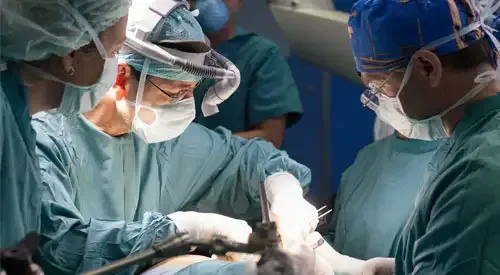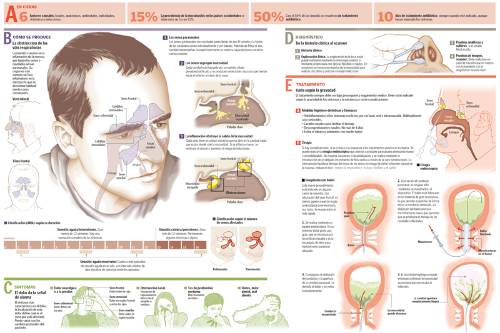Sinusitis
"Treatment should always be under prescription and medical control. It should be indicated according to the severity of symptoms and the existence or not of complications".
DR. JORGE DE ABAJO
SPECIALIST. OTORHINOLARYNGOLOGY DEPARTMENT

What is sinusitis?
A sinusitis is an inflammation of the mucosa that lines the sinuses (maxillary, ethmoidal, frontal and sphenoidal sinuses). Its origin is almost always an inflammatory focus in the nose so it is commonly referred to as rhinosinusitis.
Sinusitis can be acute when the time of evolution is less than three weeks; subacute, when symptoms persist between three weeks and three months; and chronic, when the duration of the disease is greater than three months.
The Clinic is a pioneer in Spain in the use of sinus balls. This technique can be applied under both general and local anesthesia in consultation, allowing the opening and cleaning of the sinuses in a minimally invasive way and with excellent results.

What are the symptoms of sinusitis?
In the acute form of sinusitis, there is facial pain, pressure, nasal obstruction, rhinorrhea (abundant flow of nasal mucus), decreased sense of smell, and cough. Fever, shortness of breath, fatigue, and dental pain may also occur.
In chronic sinusitis there may be: facial pain, feeling of facial pressure, nasosinus congestion, nasal obstruction, thick rhinorrhea, posterior rhinorrhea and presence of pus in the nasal cavity.
Sometimes it can also present a fever and can produce headache, difficulty in breathing and fatigue. Symptoms may persist for twelve weeks or more.
Do you have any of these symptoms?
You may have sinusitis
What are the causes of sinusitis?
The most common cause of inflammation of the sinuses and nostrils is the common cold, usually due to a viral infection.
Acute bacterial sinusitis is usually preceded by a cold of the upper respiratory tract or an allergic process or any type of environmental irritation (fumes, gases, vapors...).
Under normal conditions, the mucus produced and accumulated in the sinuses drains into the nasal cavity, but when a cold or an allergic process occurs, the mucus of the sinuses becomes inflamed and prevents the drainage of the mucus. This leads to congestion and infection.
The most common responsible germs are Streptococcus pneumoniae and Haemophylus influenzae. Unlike an upper respiratory cold or allergic process, bacterial sinusitis requires accurate diagnosis and antibiotic treatment to achieve cure and prevent possible complications.
Who can suffer from it?
Sinusitis is one of the most frequent reasons for medical consultation. It affects both children and adults. It is rare to affect only one sinus.
The osteomeatal complex, which is an area of confluence of several sinuses in the nasal cavity, is the area most often affected.
Is sinusitis cured?
The response to specific antibiotic treatment is usually satisfactory.
In cases where any of the local or systemic factors that may predispose to sinusitis are detected, it is advisable to resolve them.
This way, the short and long term prognosis is not clouded by the chronification of the sinusitis or by the appearance of complications.
How is sinusitis diagnosed?

The diagnosis of sinusitis is made primarily with data obtained after a careful history and clinical examination.
A complete study of the nasal and paranasal sinus area is advisable, with an anatomical (direct vision), physiological (study of nasal flows) and radiological (simple radiology and CT scan) view.
The exploration of the nasal cavity can be done by anterior rhinoscopy or by endoscopy with flexible or rigid optics.
In many cases it is necessary to perform radiographic examination and culture of nasal discharge to determine the extent of the disease and the cause of sinusitis.
The Clinic is a pioneer in Spain in the use of sinus balloons. This technique can be applied under both general and local anesthesia in consultation, allowing the opening and cleaning of the sinuses in a minimally invasive way and with excellent results.
How is sinusitis treated?
Acute sinusitis is a bacterial infection of the sinuses. The main treatment is the administration of oral antibiotics for a period of ten to fourteen days. Oral or topical decongestants are also commonly indicated to relieve symptoms.
The antibiotic will be as specific as possible according to the antibiogram obtained from the culture of the nasal exudate or discharge.
Chronic sinusitis, on the other hand, is a chronic inflammation of the nasal mucosa. This inflammation can be accompanied by a chronic infectious process or not.
The first choice treatment consists of the administration of antibiotics together with corticoids. In some cases it will be necessary to offer the patient treatment with oral steroids for a short period of time. The use of topical maintenance steroids is also usually proposed to improve or maintain the patient's well-being.
In the event of an accompanying infectious process, oral antibiotics will be added to this treatment as specifically as possible in accordance with the antibiogram.
Endoscopic treatment of sinusitis is reserved for those patients in whom medical treatment has not been effective, or who present some anatomical characteristic that favors the appearance of sinusitis
Endoscopic endonasal surgery is a very effective procedure. It does not require incisions or hospitalization and is performed by introducing a thin fiber optic instrument through the nose (endoscope). Through this technique different procedures can be performed with great advantages for the patient.
In the last years the Department of Otorhinolaryngology of the Clinic has been a pioneer in the realization of the balloon synuplasty. This technique consists in the introduction of a guide with a balloon at the end. When it is placed in the affected area, the balloon is inflated, which presses on the walls of the duct, widening it, facilitating the drainage of the mucus and restoring the ventilation of the cavity. This procedure is only applicable in some cases of rhinosinusitis.
This technique minimizes the risk for the patient and significantly shortens the recovery period. Another advantage of this procedure is that it can be performed under local anesthesia in consultation without the need for hospitalization in some cases.
Along with the balloon synuplasty technique, the Clinic's Department of Otolaryngology has also pioneered the use of extended release medication devices at the level of the nasal passages. This technique is indicated in those cases where nasal polyps are present.
When this occurs, oral steroid treatment is usually indicated. The use of systemic steroids can lead to side effects. Prolonged steroid-release devices allow high doses of medication to be achieved at the nasal cavity level, thus minimizing the need for systemic steroids.
Where do we treat it?
IN NAVARRA AND MADRID
The Department of Otolaryngology
of the Clínica Universidad de Navarra
The Department of Otorhinolaryngology of the University of Navarra Clinic is a national and world reference in numerous highly specialized surgical procedures.
We have the latest technology and we perform all diagnostic tests in less than 48 hours in order to offer our patients the best solution in the shortest time possible.
We were one of the first centers in Spain to use robotic surgery in the surgical treatment with the Da Vinci® System.
Organized in specialized units:
- Otology - Hearing.
- Rhinology - Nose.
- Pharyngology - Throat.
- Laryngology - Voice.
- Balance disorders.
- Head and neck problems.

Why at the Clinica?
- Experts in the treatment of hearing problems.
- Pioneers in axillary surgery to avoid scarring.
- National reference center in tissue sealing for tonsil removal.















